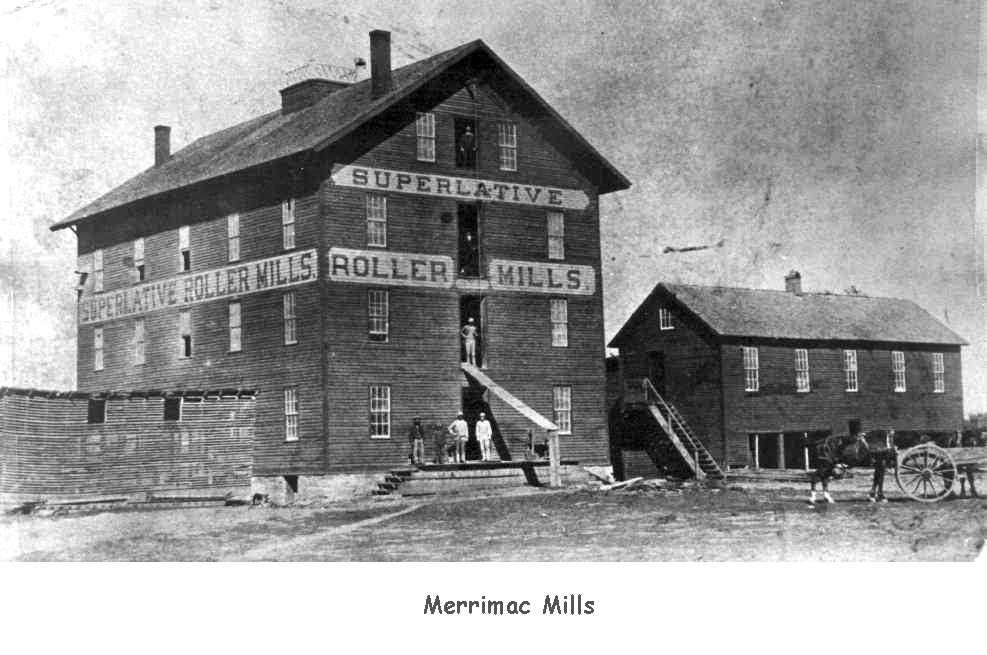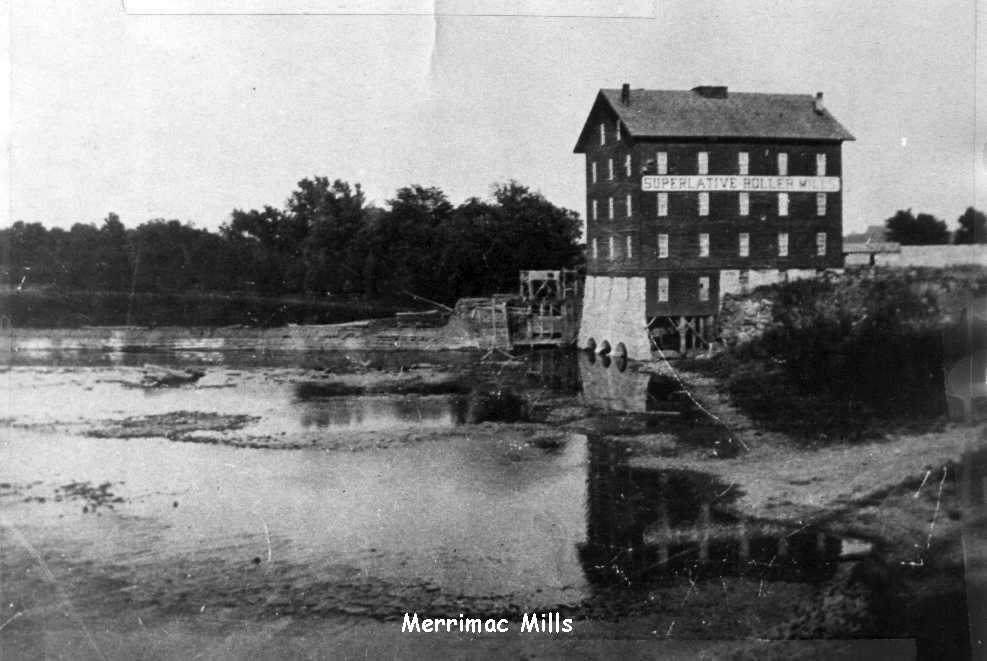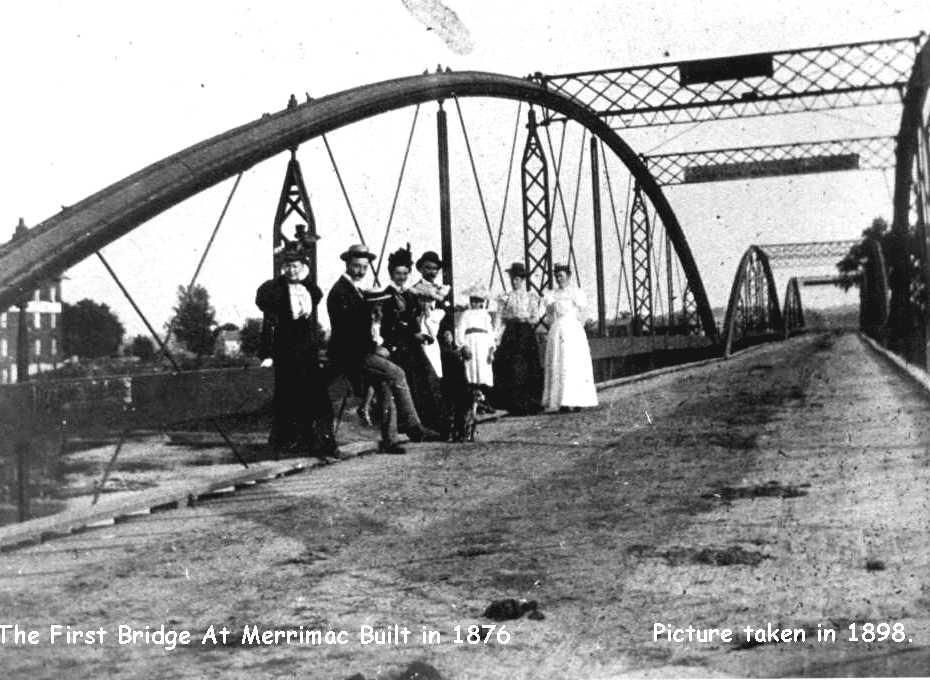 |
of Jefferson County |
 |
 |
of Jefferson County |
 |
Deedsville/Merrimac
(Walnut Township)
"DEEDSVILLE. A mill, post and trading village in Sec. 36, Walnut Township, on the east bank of Skunk River. P.O. Est. 15 Jul 1849; Silas Deeds, owner and founder of the town, was postmaster; discontinued 10 Dec 1853."
"MERRIMAC. First named Deedsville.
It was given the new name in war times, and the act occasioned some excitement
because the name was that of the rebel battleship. P.O. Est. 13
Jun 1866 with Wm. J. Rodgers as first postmaster; succeeded by Robert C.
Risk, William Frier, Charles Bryan, Joseph A. Salzman, and Wade R. Carper.
Never was platted. In 1888 the land was believed to be assessed higher
than any other "acre" property in Iowa. When the mills ceased operations
and the last store closed, Merrimac became almost a vanished village but
lives on in the memories of older citizens. Later the name was changed
to Merrimac."
The above information was compiled by Mary Prill and
published in the Hawkeye Heritage, July 1967.
* * * * * * * * * * * * * * *
The following article was reprinted from and with the permission of the Fairfield Ledger January 28, 2000, page 8C
Names mentioned in this article are:
Silas
Deeds; John Roberts; W. J. and J. S. Rodgers; Mr. Shadle; Iliff Upton;
C. R. Risk; C. C. Risk; C. A. Bryan; Jim Green; Peter Salzman; Art Salzman.
Headlines
"First ‘Deedsville,’ Merrimac was built on its mills"
 .
.
 .
.
MERRIMAC MILLS - Silas Deed sawed the timber for a grist mill in 1850. The building pictured above was taken down and most of the material converted to fuel.
By ANNA SALZMAN
"Probably no mills along the river or creeks have served more people
of Henry County than the mills at Merrimac, just across the county line
in Jefferson County.
Merrimac was, in the earlier days, known as "Deedsville,"
deriving its name from Silas Deeds, who built the first dam at this place
in 1849 - 50.
John Roberts of Trenton came to Iowa in 1855 and has lived
in the vicinity ever since. He tells us he remembers the story from
the time the first log was hauled. According to Mr. Roberts, a saw
mill was set up on the west side of the river in 1850 where Silas Deed
sawed the timbers for the grist mill and hauled them across to the east
side. There was no bridge at this time so ford and ferry were used.
Much fine oak timber was still uncut on the west side.
About the time the framing for the grist mill was finished,
the high water of 1851 washed away building, timbers and lumber.
Undaunted, Mr. Deeds sanded out another frame and lumber and the Deedsville
flour mill was finished in 1853. This mill was two stories with a basement
and a flat roof. It had four pairs of buhrs, three for flour and
one for corn meal.
Silas Deeds was a good, but surly old man. Sometimes
he would talk and sometimes he would not, but Deedsville was a busy little
place, feeding cattle, raising and feeding hogs (for some 300 acres of
land were included in the mill holdings), grinding flour and meal and doing
custom sawing for farmers on the three hundred plus acres of land included
in the mill holdings.
In the fall of 1862, Mr. Deeds died of smallpox and was buried
in Green Mound cemetery in Trenton. The property was then purchased by
W. J.. and J. S. Rodgers. About 1865 the grist mill burned.
This mill was some smaller on the foundation, 40x60, but
had a basement and three stories with a gable roof. This made four floors
for work. A Mr. Shadle, who lived where Iliff Upton now lives northwest
of Mount Pleasant, was the chief architect and builder and Mr. Roberts
says "The framer who couldn't mortise and tenant (sic) to his fine lines didn't
stay on the job long."
When this mill was painted, the sign painter printed across
the front in big bold letters "W. J. and J. S. Rodgers, Merrimac Mills,"
and from that time Deedsville become Merrimac.
Rodgers Bros. firm become a sort of bank for the farmers
who found it handy to carry their spare cash to them. And the firm continued
their building. They built a carding and spinning mill, and when the
farmer took his grist to mill the women sent along some wool to be carded
and made into rolls and spun into yarn.
They also built tenement houses and "put in a good country
store without whiskey, which was something unusual for those times."
About this time the ferry was put out of business by an iron bridge.
The firm employed much labor and paid good wages and took
the entire output of the community's produce. They were paying as
high as $3.33 1/3 per bushel for wheat, and as the sudden deflation in
prices, following the Civil War, spread over the country the prosperous
firm of W. J. and J. S. Rodgers failed as did many others. The farmers
who had placed their money with them received 14 cents on the dollar.
The business was then taken over by C. R. Risk, an old gentleman
of Brighton who had business interests with the Rodgers firm. Mr.
Risk rode on horseback all kinds of weather, the nine miles to and from
his home, daily.
Eight years later the business passed into the hands of his
son, C. C. Risk of Fairfield. A few months later the firm became
Risk, Brier and Law; it was purchased again by C. C. Risk and again an
interest was sold to C. A. Bryan of Agency. Risk and Bryan took out the
old buhrs and installed the new roller system in about 1879-80.
During the remodeling of the mills a young man, then twenty
years of age, came from Ohio and became a clerk in the store which was
rented from the mill firm by Jim Green now of Winfield. The new firm of
Risk and Bryan then decided to discontinue renting the store but to operate
it with the mill business. The young man continued in the employment of
this firm until he bought a one third interest in 1888, when the firm became
Bryan, Risk and Salzman and so continued until 1895 when Peter Salzman
bought the entire business and "Superlative Roller Mills" was painted on
the building.
Mr. Salzman continued making flour until 1903 when all small
flour mills along the rivers became unprofitable. Some mills
may have served the county longer by grinding feed and meal but this was
the last to discontinue making flour. From 1903 on the machinery
was offered for sale but then no market for it, save for junk, excepting
a few pulleys, belting and some shafting. In 1924, the building was
taken down and most of the material converted into fuel.
The timbers of the upper story and gable, however, were saved
intact, and used to build a 40x60 machine shed which stands near the site
of the old mill. The building was erected by Art Salzman with one
helper and contains the 12-inch-by-12 inch timbers, the sills, posts, plates,
purlings and rafters of the upper story, and gable of the old mill.
The frame is pinned together with the old wooden pins and stands on its
new foundation, just as it stood on the second story of the Merrimac Mills
for nearly sixty years."